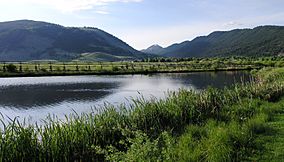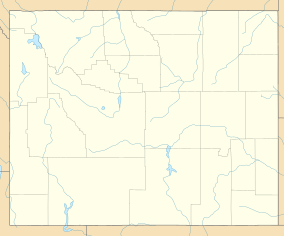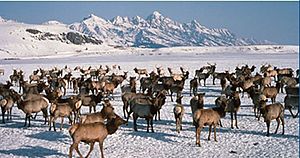National Elk Refuge facts for kids
Quick facts for kids National Elk Refuge |
|
|---|---|
|
IUCN Category IV (Habitat/Species Management Area)
|
|

Wetlands on the National Elk Refuge
|
|
| Location | Teton County, Wyoming, United States |
| Nearest city | Jackson, WY |
| Area | 25,000 acres (100 km2) |
| Established | 1912 |
| Governing body | U.S. Fish and Wildlife Service |
| Website | National Elk Refuge |
The National Elk Refuge is a special wildlife refuge in Wyoming, a state in the United States. It's located in a valley called Jackson Hole. This refuge was created in 1912 to protect a huge herd of elk, also known as wapiti. It gives them a safe place to live and find food.
The refuge covers about 24,700 acres, which is like 25,000 football fields! It's next to the town of Jackson, Wyoming, the Bridger-Teton National Forest, and Grand Teton National Park. Every winter, around 7,500 elk come here. The U.S. Fish and Wildlife Service manages this important area.
Contents
Why the Refuge Was Created
The elk at the refuge travel a long way, sometimes from as far as southern Yellowstone National Park. Long ago, they would move to the Jackson Hole area in winter. This spot had less snow and more grass, offering a safe place to survive the cold. In spring, they would follow the melting snow back north.
Elk Migration Challenges
The elk herd used to be much bigger, with over 25,000 animals. But by the late 1800s, the town of Jackson grew. This blocked some of the elk's natural travel paths. The herd also faced tough weather, not enough food, and hunting by people in the area. This caused the number of elk to drop a lot.
Protecting the Herd
People realized the elk needed help. So, in the early 1900s, a plan began to protect the remaining elk. In 1912, the government bought some land, and that's how the National Elk Refuge was started. It became a safe haven for these amazing animals.
How the Refuge Helps Elk Survive
The National Elk Refuge helps the elk get through the tough winters in Jackson Hole. They have a special program where they give the elk extra food. This helps them stay strong when natural food is scarce.
Antler Collection and Sale
Elk grow large antlers every year, which they shed in the spring. Since 1968, the Boy Scouts of America have helped collect these antlers. They sell them at an auction, and 75% of the money goes back to the refuge. This money is used to water the grasses, making sure there's plenty of natural food for the elk. Thousands of pounds of antlers are sold each year!
Sleigh Rides for Visitors
During the winter, visitors can take fun horse-drawn sleigh rides. This allows people to get a close-up look at the elk herd. It's a great way to see these animals in their natural winter home.
Managing the Elk Population
The refuge also has a carefully managed program to help control the elk population. This ensures the herd stays healthy and doesn't get too large for the available food and space.
Animals of the Refuge
The National Elk Refuge is a home for many different animals, not just elk! It has about 25,000 acres of meadows and marshes, along with sagebrush and rocky areas.
Other Large Animals

- Bison: The refuge is home to the largest group of bison managed by the government. Over 1,000 of these big animals spend their winters here.
- Other Hoofed Animals: You can also find Bighorn sheep, pronghorn, and mule deer roaming the refuge.
- Predators: Sometimes, wolf packs and grizzly bears are seen, though they are rare. Coyotes and red foxes are much more common.
Birds of the Refuge
The refuge is a great place for birdwatching! Many different bird species live here.
- Common Birds: You'll often see red-winged blackbirds, magpies, crows, and ravens.
- Waterfowl: Along Flat Creek, which flows through the refuge, you might spot beautiful trumpeter swans.
In total, 47 different kinds of mammals and 147 different bird species have been recorded living on the refuge.
Climate and Environment
The National Elk Refuge has a lower elevation than much of the Greater Yellowstone Ecosystem. This means it has a milder climate, which is why so many animals come here for the winter.
Most of the refuge is covered in snow from November to March. However, sunny days often follow snowfalls, causing some of the snow to melt. Also, slopes that face south usually don't have snow for most of the winter, providing more access to food for the animals.
Images for kids







